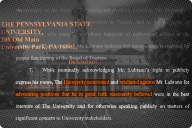You have /5 articles left.
Sign up for a free account or log in.
Reporter Jack Stripling has an article on green computing in today's edition. I don't know Jack. It's a pretty good article (not that I'm any judge). One minor nit, though, and a couple of things to add.
First, the nit. I know that, in a periodical targeted to academicians, no reader would ever form an impression based solely on the headline. (And I know how hard it can be to find a good headline -- or even a mediocre one.) Still, I do wish he hadn't used the terms "gutless" and "green" in such close juxtaposition. True, an energy-efficient 'thin client' has fewer innards than a traditional desktop PC, but 'gutless' could easily be read to imply a lack of performance, or a lack of overall capability. Nothing could be further from the truth.
'Thin client' computing has the capability to make the entire number-crunching power of a high-dollar server available at your desktop, as if it were physically located there. From a statistician's perspective, running multiple regressions on truly large databases becomes both easy and fast. From a sustainability administrator's perspective, the fact that electricity consumption goes down by an order of magnitude is great. And the fact that 'thin client' desktops with LCD monitors generate no virtually no heat is even better news. Verdict: green, for sure; gutless, only technically.
From a campus perspective, however, there are other advantages which can make thin client computing an even easier sale where it counts -- in the halls of the technorati and their managers.
First, putting 99% of the software on a small number of servers (as opposed to a ridiculous number of desktops) makes managing and supporting that software both easier and cheaper. It also eliminates much of the configuration variety which is the current bane of your help desk support staff.
Second, minimizing the complexity of the hardware distributed across campus decreases your exposure to advancing technology. Desktop computers at Greenback get replaced, on average, every four years. 'Thin client' desktop hardware should still be current and capable (for administrative computing purposes) after at least twice that long. The centralized servers will still have to be upgraded every few years, but monitors, keyboards, and low-load processor chips should last quite a while. (There isn't even a fan to wear out.)
The techno-sperts at Greenback aren't averse to the idea of sustainability, but it doesn't really grab them where they live. Their managers, however, can readily see the compelling logic in a set of technologies which offers lower maintenance costs, lower support costs, lower electrical energy costs, lower HVAC demands, easier standardization, easier security (fewer points of vulnerability on the network), and longer equipment lifespans.
The case for thin-client computing is one I started making on campus a while ago. We're piloting it in a number of locations. We're at the point of establishing standard configurations for roll-out across campus. And, so far, push-back has been minimal.





